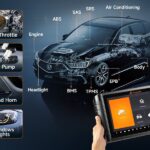Navigating the complexities of vehicle maintenance can sometimes feel like deciphering a secret code. One area that often puzzles car owners, especially after performing repairs, is the OBDII drive cycle. If you’re a Hyundai owner and have encountered issues getting your vehicle’s OBDII system ready for an inspection, you’re not alone. Let’s break down what an OBDII drive cycle is and how it relates to your Hyundai.
After addressing a car issue, like replacing spark plugs and wires or cleaning the throttle body as mentioned in a forum discussion, you might expect everything to be smooth sailing. However, you might find your Malfunction Indicator Lamp (MIL), or check engine light, illuminated. Even after clearing codes with an OBDII scanner, you might notice that some system monitors are not setting to “ready.” This is where the OBDII drive cycle comes into play, particularly for specific makes like Hyundai.
The OBDII (On-Board Diagnostics II) system is designed to monitor your vehicle’s emission control systems. When you clear trouble codes, you’re essentially resetting the system. To ensure your car is actually running cleanly and efficiently, the OBDII system needs to re-run a series of self-tests, known as monitors. These monitors check various components like the oxygen sensors (HO2S), evaporative emissions system (EVAP), and catalytic converter (CAT).
These monitors don’t run instantaneously. They require specific driving conditions to be met, which collectively are known as a “drive cycle.” Think of it as a checklist your Hyundai’s computer needs to go through to verify everything is working correctly after a reset or repair.
Common monitors that often take time to become ready include:
- EVAP (Evaporative System) Monitor: This checks for fuel vapor leaks in your Hyundai’s fuel system. It often requires multiple cold starts and specific temperature conditions to run.
- CAT (Catalyst) Monitor: This assesses the efficiency of your catalytic converter in reducing emissions. It typically runs after other monitors have completed and requires the engine to reach operating temperature.
- HO2S (Heated Oxygen Sensor) Monitor: This monitors the performance of your oxygen sensors, which are crucial for fuel efficiency and emissions control. It usually requires the engine to reach operating temperature and a period of steady cruising.
The frustration often arises when monitors, especially the HO2S monitor, don’t become ready as quickly as expected. As one user pointed out, the HO2S test should theoretically be one of the faster ones to complete, simply requiring a warmed-up engine and steady speed driving.
If you’re facing this situation with your Hyundai, here are some key steps and considerations:
-
Understand the Drive Cycle: While there isn’t one universal OBDII drive cycle, manufacturers like Hyundai have specific procedures. These usually involve a combination of cold starts, idling, acceleration, deceleration, and steady cruising at various speeds. Consult your Hyundai owner’s manual or a reliable repair information source for the specific drive cycle recommended for your model. While a generic drive cycle might help, adhering to Hyundai’s recommended procedure is more likely to yield faster results.
-
Avoid Generic Code Clearing: While OBDII scanners are useful, repeatedly clearing codes without addressing the underlying issue can prolong the readiness process. Ensure you’ve properly fixed the initial problem that triggered the codes (like the MAF sensor issue mentioned in the original discussion).
-
Drive Under Varied Conditions: Instead of just short trips, incorporate driving that includes highway speeds, stop-and-go traffic, and some idling time. This helps to satisfy the conditions for different monitors to run.
-
Be Patient: OBDII monitors, especially EVAP and CAT, can take several drive cycles to complete. Don’t expect instant readiness. Continue driving your Hyundai under varied conditions for a few days.
-
Consider a “Forced” Drive Cycle (If Necessary and Safe): If time is pressing and you need your Hyundai inspected, and you’ve confirmed the specific Hyundai drive cycle procedure, you can attempt to follow it precisely in a safe driving environment. This might involve specific acceleration and deceleration patterns and maintaining certain speeds for set durations. However, always prioritize safety and be aware of traffic conditions when performing such procedures.
In conclusion, understanding the OBDII drive cycle is crucial for Hyundai owners to ensure their vehicles are ready for emission inspections after repairs. While frustrating when monitors are not immediately ready, patience and following a proper drive cycle procedure, ideally the Hyundai-specific one, are key to resolving the issue and getting your vehicle compliant. If you continue to experience problems, consulting a qualified mechanic familiar with Hyundai vehicles and OBDII systems is always a wise step.


